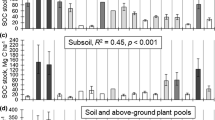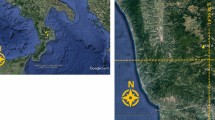Abstract
In the context of global carbon cycle management, accurate knowledge of carbon content in forests is a relevant issue in contemporary forest ecology. We measured the above-ground and soil carbon pools in the dark-coniferous boreal taiga. We compared measured carbon pools to those calculated from the forest inventory records containing volume stock and species composition data. The inventory data heavily underestimated the pools in the study area (Stolby State Nature Reserve, central Krasnoyarsk Territory, Russian Federation). The carbon pool estimated from the forest inventory data varied from 25 (t ha−1) (low-density stands) to 73 (t ha−1) (highly stocked stands). Our estimates ranged from 59 (t ha−1) (low-density stands) to 147 (t ha−1) (highly stocked stands). Our values included living trees, standing deadwood, living cover, brushwood and litter. We found that the proportion of biomass carbon (living trees): soil carbon varied from 99:1 to 8:2 for fully stocked and low-density forest stands, respectively. This contradicts the common understanding that the biomass in the boreal forests represents only 16–20 % of the total carbon pool, with the balance being the soil carbon pool.
Similar content being viewed by others

References
Alexeev VA, Berdsy RA (1994) Carbon in ecosystems of forests and peatlands of Russia. Publishing house of Institute of Forest of Siberian Branch of Russian Academy of Sciences, Krasnoyarsk, p 532 (in Russian)
Bazilevich NI, Titlyanova AA (2008) Biotic turnover on five continents: element exchange processes in terrestrial natural ecosystems. Publ. house SB RAS, Novosibirsk, p 380 (in Russian)
Gavrikov VL, Khleboros RG (2013) A conceptual model to analyze ecological and economical values of forest. Inzhenernaya Ecol 5:38–47 (in Russian)
IPCC (Intergovernmental Panel on Climate Change) (2001) Observed climate variability and change. In: Houghton JT, Ding Y, Griggs DJ, Noguer M, van der Linden PJ, Dai X, Maskell K, Johnson CA (eds) Climate Change 2001: the scientific basis. Contribution of Working Group I to the Third Assessment Report of the IPCC. Cambridge University Press, Cambridge, pp 99–181
IPCC (Intergovernmental Panel on Climate Change) (2013) Climate change 2013: the physical science basis. In: Stocker TF, Qin D, Plattner GK, Tignor M, Allen SK, Boschung J, Nauels A, Xia Y, Bex V, Midgley PM (eds) Contribution of Working Group I to the Fifth Assessment Report of the Intergovernmental Panel on Climate Change. Cambridge University Press, Cambridge, p 1535
Kachinsky NA (1965) Fizika Pochvy [Soil physics], vol I. Higher School Publishing, Moscow, p 323 (in Russian)
Klimchenko AV, Verlhovets SV, Slinkina OA, Koshurnikova NN (2011) The stock of large wood remains in middle-taiga ecosystems of Yenissei Siberia. Geografia i prirodnye resursy 2:91–97 (in Russian)
Luyssaert S, Schulze ED, Börner A, Knohl A, Hessenmöller D, Law BE et al (2008) Old-growth forests as global carbon sinks. Nature 455:213–215
Magnani F, Mencuccini M, Borghetti M, Berbigier P, Berninger F, Delzon S et al (2007) The human footprint in the carbon cycle of temperate and boreal forests. Nature 447:849–851
McGuire AD, Sitch S, Clein JS, Dargaville R, Esser G, Foley J, Heimann M, Joos F, Kaplan J, Kicklighter DW, Meier RA, Melillo JM, Moore B III, Prentice IC, Ramankutty N, Reichenau T, Schloss A, Tian H, Williams LJ, Wittenberg U (2001) Carbon balance of the terrestrial biosphere in the twentieth century: analysis of CO2, climate and land-use effects with four process-based models. Glob Biogeochem Cycles 15:183–206
Pan Y, Birdsey RA, Fang J, Houghton R, Kauppi PE, Kurz WA, Phillips OL, Shvidenko A, Lewis SL, Canadell JG, Ciais P, Jackson RB, Pacala SW, McGuire AD, Piao S, Rautiainen A, Sitch S, Hayes D (2011) A large and persistent carbon sink in the world’s forests. Science 333:988–993
Pleshikov FI, Kaplunov VJ, Tokmakov SV, Ben’kov AV, Titov SD, Pervunin VA (2002) Phytomass structure and annual production of boreal forests. In: Pleshikov FI (ed) Forest ecosystem of the Yenisey Meridian. Publishing house of SB RAS, Novosibirsk, pp 73–84 (in Russian)
Roulet NT (2000) Peatlands, carbon storage, greenhouse gases, and the Kyoto protocol: prospects and significance for Canada. Wetlands 20(4):605–615
Schimel DS, Melillo J, Tian H, McGuire AD, Kicklighter D, Kittel T, Rosenbloom N, Running S, Thornton P, Ojima D, Parton W, Kelly R, Sykes M, Neilson R, Rizzot B (2000) Contribution of increasing CO2 and climate to carbon stock by ecosystems in the United States. Science 287:2004–2006
Scholze M, Kaplan JO, Knorr W, Heimann M (2003) Climate and interannual variability of the atmosphere-biosphere 13CO2 flux. Geophys Res Lett 30(2):1097. doi:10.1029/2002GL015631
Schulze E-D (2000) Carbon and nitrogen cycling in European forest ecosystems. Springer, Berlin, p 500
Schulze E-D, Lloyd J, Kelliher FM, Wirth C, Rebmann C, Lühker B, Mund M, Knohl A, Milyukova IM, Schulze W, Ziegler W, Varlagin AB, Sogachev AF, Valentini R, Dore S, Grigoriev S, Kolle O, Panfyorov MI, Tchebakova N, Vygodskaya NN (1999) Productivity of forests in the Eurosiberian boreal region and their potential to act as a carbon sink—a synthesis. Glob Change Biol 5:703–722
Shvidenko AZ, Nilsson S, Stolbovoy VS, Gluck M, Shepacshenko DG, Rozchkov V (2000) Aggregated estimation of the basic parameters of biological productivity and carbon budget of Russian terrestrial ecosystems: 1. Stocks of organic mass. Russ J Ecol 6:403–410
Sohngen B, Sedjo R (2006) Carbon Sequestration in Global Forests Under Different Carbon Price Regimes. Energy J 27(Special issue 3):109–126
Utkin AI, Zamolodchikov DG, Chestnyh OV, Korovin GN, Zukert NV (2001) Russian forests as a reservoir of the organic carbon of biosphere. Lesovedenie 5:8–23 (in Russian)
Vasander H, Kettunen A (2006) Carbon in boreal peatlands. In: Wieder RK, Vitt DH (eds) Boreal peatland ecosystems. Ecological studies, vol 188. Springer, Berlin, pp 165–195
Zamolodchikov DG, Utkin AI, Korovin GN, Chestnykh OV (2005) Dynamics of carbon pools and fluxes in Russia’s forest lands. Russ J Ecol 36(5):291–301
Acknowledgments
The study was supported by the Russian Foundation for Basic Research, research grant 14-05-00831 ‘The landscape features and the integral assessment of carbon storing function in protected forest areas of Siberian southern taiga’. Authors are grateful to an anonymous reviewer whose comments helped to improve the manuscript. The authors declare that they have no conflict of interest.
Author information
Authors and Affiliations
Corresponding author
Additional information
Project funding: This research was supported by Russian Foundation for Basic Research, research grant 14-05-00831.
The online version is available at http://www.springerlink.com
Corresponding editor: Zhu Hong
Rights and permissions
About this article
Cite this article
Gavrikov, V.L., Sharafutdinov, R.A., Knorre, A.A. et al. How much carbon can the Siberian boreal taiga store: a case study of partitioning among the above-ground and soil pools. J. For. Res. 27, 907–912 (2016). https://doi.org/10.1007/s11676-015-0189-7
Received:
Accepted:
Published:
Issue Date:
DOI: https://doi.org/10.1007/s11676-015-0189-7



